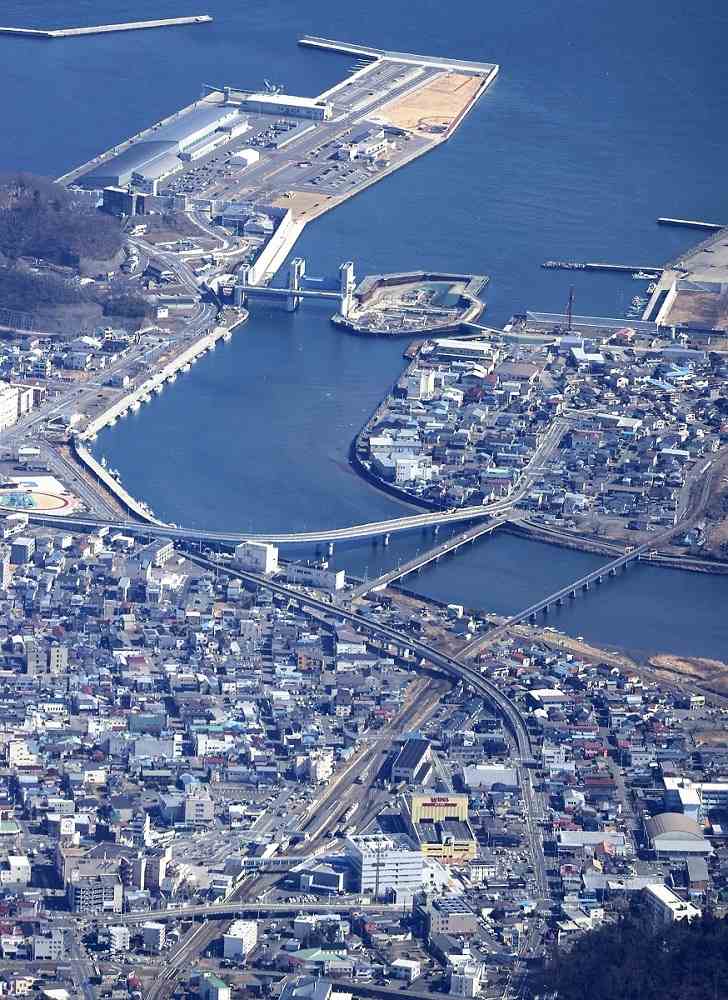12 Years After Great East Japan Earthquake / Eastern Japan Weighs Response in Case of Another Disaster

The new municipal building in Miyako, Iwate Prefecture, which is expected to be inundated following a major earthquake, is seen from the air on Feb. 27.
The Yomiuri Shimbun
2:00 JST, March 11, 2023
Saturday marks 12 years since the 2011 Great East Japan Earthquake. While continuing to grapple with post-quake reconstruction issues, affected communities are giving serious thought to how best to prepare for another calamity. This is the first installment of a series in which we take a close look at the main issues to be addressed.
***
Devastating potential

Following a 2020 government announcement regarding an anticipated earthquake that could be even more devastating than the 2011 quake, coastal municipalities in Iwate, Miyagi, and Fukushima prefectures, which were heavily damaged by the temblor and tsunami, have been weighting their respective responses to another catastrophe.
The three prefectures last year estimated a 30% expansion in the area that would be inundated, based on the government’s prediction of a “largest-scale tsunami.”
A survey conducted by the Yomiuri Shimbun in January found that 42 facilities, or 40% of the key disaster-response facilities in 37 coastal municipalities — including main government offices and fire stations — are at risk of inundation.
Municipalities that have taken countermeasures based on lessons learned from the 2011 disaster voiced exasperation regarding these results, questioning the meaning of their efforts over the past dozen years.
In April 2020, the government released a map of areas likely to be inundated by a tsunami following a magnitude 9 earthquake with an epicenter in or around the Japan Trench and Chishima Trench off the coast of the Tohoku region and Hokkaido. In December 2021, Tokyo also posited that in a worst-case scenario — such as a massive earthquake occurring late at night during wintertime — up to 199,000 people could die, eclipsing the number of people who perished in the 2011 quake.
In response, during the period from March to December last year, the three prefectures released their own inundation and damage estimates. According to these estimates, the maximum expected tsunami height is 29.5 meters in Miyako, Iwate Prefecture. The total area predicted to be inundated in the three prefectures has been expanded to 630 square kilometers — or an area 30% larger than 2011 — with the anticipated death toll rising to as high as 14,249.
Regarding areas anticipated to be inundated, the Yomiuri Shimbun surveyed 37 coastal municipalities of cities, towns, and villages in the three prefectures in January, and found that 18 main municipal office buildings (or 49% of all such buildings), 15 fire stations (or 38%), and 9 police stations (or 38%), were located within the anticipated areas. When branch offices of the municipal governments and police boxes are included, the total number of such disaster-response bases that could be flooded is 120.
If key disaster-response facilities were to be flooded, tasks such as guiding people to shelters and carrying out lifesaving activities could be hindered.
In the 2011 quake, municipal government offices in Rikuzentakata City and Otsuchi Town in Iwate Prefecture, and those of Minami-Sanriku and Onagawa towns in Miyagi Prefecture were destroyed by flooding. Six of the 18 main municipal government offices thought to be at risk of possible inundation were relocated following the 2011 earthquake.
The municipal government office in Miyako, which was submerged up to the second floor in 2011, was relocated further inland in 2018. However, the latest hypothesis suggests the city could see up to 18.7 square kilometers of flooding, nearly twice the area affected previously. Concerned that the new government building could be hit by potential flooding of up to 2.92 meters, the city decided to install pumps to supply fuel to the emergency power generators on the second floor and higher.
“We’ll work to the bitter end to respond [appropriately] by assuming a worst-case scenario, but what should we do about our town building?” Miyako Mayor Masanori Yamamoto said.
Meanwhile, the city government of Kamaishi, Iwate Prefecture, has modified the floor plan for its new planned government building. Worried that the building could be flooded by between 3 meters and 5 meters of water, it has relocated the planned administrative offices to the second floor and above.
Kamaishi Mayor Takenori Noda lamented, “With these latest estimates, it feels like our post-quake reconstruction goals have become even more distant.”
Popular Articles
Popular articles in the past 24 hours
-

Japan's H3 Rocket Failed in Latest Launch, Says Official
-

Hong Kong Police Detain 15 in Robbery Case Involving Theft of ¥1 ...
-

Suntory CEO Says Beer to Be Company's ‘Top Priority;’ Tax Cut on ...
-

Japanese Prime Minister Sanae Takaichi to Move into Official Resi...
-

Japanese Govt to Trial Offering Bidding Preference to Constructio...
-

Imperial Family Views Photo Exhibition Themed on Wartime Tokyo to...
-

Poll Finds High Approval Rating for PM Takaichi’s Economic Measur...
-

A Middle-Class Family's Only Option: A $43,000 Health Insurance P...
Popular articles in the past week
-

Israeli Tourists Refused Accommodation at Hotel in Japan’s Nagano...
-

U.S. Senate Resolution Backs Japan, Condemns China's Pressure
-

Kenta Maeda Joins Rakuten Eagles; Returns from American MLB to Ja...
-

Sharp Decline in Number of Chinese Tourists But Overall Number of...
-

China Attacks Japan at U.N. Security Council Meetings; Representa...
-

Japan Set to Participate in EU's R&D Framework, Aims to Boost Coo...
-

Japan Backs Public-Private Cooperation on Economic Security; Nati...
-

Bus Bound for Hokkaido's New Chitose Airport Catches Fire Wednesd...
Popular articles in the past month
-

Tokyo Economic Security Forum to Hold Inaugural Meeting Amid Tens...
-

Keidanren Chairman Yoshinobu Tsutsui Visits Kashiwazaki-Kariwa Nu...
-

Imports of Rare Earths from China Facing Delays, May Be Caused by...
-

University of Tokyo Professor Discusses Japanese Economic Securit...
-

Japan Pulls out of Vietnam Nuclear Project, Complicating Hanoi's ...
-

Govt Aims to Expand NISA Program Lineup, Abolish Age Restriction
-

Blanket Eel Trade Restrictions Rejected
-

Key Japan Labor Group to Seek Pay Scale Hike
"Society" POPULAR ARTICLE
-

M4.9 Earthquake Hits Tokyo, Neighboring Prefectures
-

Israeli Tourists Refused Accommodation at Hotel in Japan’s Nagano Pref., Prompting Protest by Israeli Embassy and Probe by Prefecture
-

M7.5 Earthquake Hits Northern Japan; Tsunami Waves Observed in Hokkaido, Aomori and Iwate Prefectures
-

Tsukiji Market Urges Tourists to Avoid Visiting in Year-End
-

M5.7 Earthquake Hits Japan’s Kumamoto Pref., Measuring Upper 5 Intensity, No Tsunami Expected
JN ACCESS RANKING
-

Tokyo Economic Security Forum to Hold Inaugural Meeting Amid Tense Global Environment
-

Keidanren Chairman Yoshinobu Tsutsui Visits Kashiwazaki-Kariwa Nuclear Power Plant; Inspects New Emergency Safety System
-

Imports of Rare Earths from China Facing Delays, May Be Caused by Deterioration of Japan-China Relations
-

University of Tokyo Professor Discusses Japanese Economic Security in Interview Ahead of Forum
-

Japan Pulls out of Vietnam Nuclear Project, Complicating Hanoi’s Power Plans







